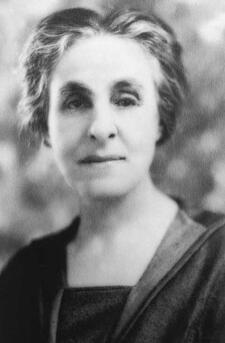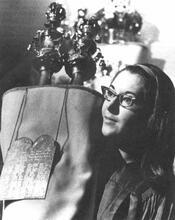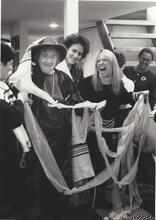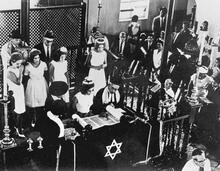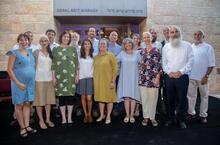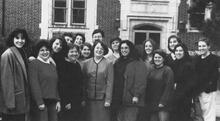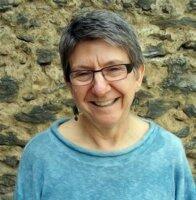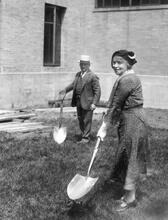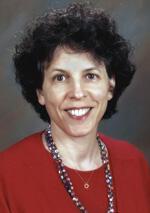Rabbis in the United States
What is history to one generation is commonplace to another. Here is Sally Priesand (center) on her visit to Hebrew Union College - Jewish Institute of Religion on the twenty-fifth anniversary of her graduation. Everyone else in the picture is a rabbinical student, except for Karla Goldman, second from right, a faculty member.
Institution: Karla Goldman
The battle for women’s rabbinic ordination opened in the late nineteenth century as American women were clamoring for admission to other learned professions. It took about a century for women to win admission to the male bastions of the rabbinate in the various streams of American Judaism, although women’s right to rabbinical ordination remains contested in much of the Orthodox world today. By the twenty-first century, hundreds of female rabbis had brought their commitments to Jewish traditions, their talents, and also their female and feminist perspectives to this historic calling. The result has been, especially in the liberal sectors of Judaism, transformations of Jewish religious life.
In 1972, Sally Priesand became the first woman ordained a rabbi, teacher, and preacher in America. Since then hundreds of women have become rabbis in the Reform, Reconstructionist, and Conservative branches of American Judaism. In recent years, women, using a variety of titles, including rabbi, have also entered the Orthodox rabbinate.
Can a Woman be a Rabbi?
Women’s recent entrance to the brotherhood of the rabbinate masks a lengthy history of the question of women’s ordination. In almost every decade since the 1890s, the challenge to the male hegemony over the rabbinate was raised in some sector of American Jewish life. At times discussions surfaced in the Jewish press and at meetings of various Jewish organizations. But generally in these settings the question was abstract. Not only would its outcome scarcely affect the lives of those engaged in the debate, but as one observer noticed in 1897, there were no women then—or so she assumed—who wanted to be rabbis.
Yet parallel to this hypothetical debate were those who sought rabbinical ordination for themselves, as Sally Priesand later would. Like the nineteenth-century pioneers who tried to crash the barriers against women in American medicine, law, and the ministry, these women enrolled in rabbinical school, expecting to be ordained.
In 1889, the journalist Mary M. Cohen, a member of a traditional Philadelphia synagogue, broached the topic of women rabbis in a story on the front page of The Jewish Exponent. She asked: Could not our women contribute to American Judaism by becoming rabbis? The arguments she presented in favor of the female rabbi revealed a climate of rising expectations for changing women’s roles in American Judaism.
From the 1890s forward, the question eddied out to American Jewry, striking a particularly responsive chord among Reform Jews. Yet, in these early years, the issue, as Cohen had shown, was by no means confined to Reform Judaism. By the beginning of the twentieth century, those at more traditional institutions, such as Conservative Judaism’s Jewish Theological Seminary, were aware of the emerging debate. In 1903, when Henrietta Szold, the foremost Jewish woman of her day, went to meet with the seminary’s president Solomon Schechter about studying there, the subject came up. As she subsequently wrote: “After he was assured that I was not an aspirant after Rabbinical honors, he agreed to put no obstacles in my way.”
From time to time over the course of the next century, committed American Jews—rabbis and rebbetzins [rabbis’ wives], sisterhood presidents and seminary professors, and men and women committed to shaping Judaism in the spirit of democratic egalitarianism—continued their theoretical debate about the question of women’s ordination. As they did, they could point to a small number of trailblazers who presented case studies of women functioning—albeit unofficially—as rabbis.
Although Jewish history offers a long list of erudite women, some even seen as almost rabbis, the first American proto-rabbi was Ray Frank. In 1890, learning that there were to be no High Holiday services in Spokane, Washington, Frank, a Sabbath school principal, agreed to preach. From then until shortly before her marriage a decade later, this “girl rabbi of the Golden West,” as the press dubbed her, preached, led religious services, and wrote about what she would do if she were a rabbi, proclaiming that she did not desire to be one.
Frank was followed by other women who, unexpectedly, found themselves leading and preaching as if they were rabbis. Among them was rebbetzin Paula Ackerman of Meridian, Mississippi. In 1950, when her husband, William Ackerman, rabbi of Temple Beth Israel, died, the congregation’s president asked her to fill in temporarily. For the next three years, until a man replaced her, she conducted weddings and funerals, led services, and preached. Her rabbinate gave Reform Judaism’s leaders the opportunity to reiterate what, by 1950, had long been their official stance: In principle, women could be rabbis; in practice, none were.
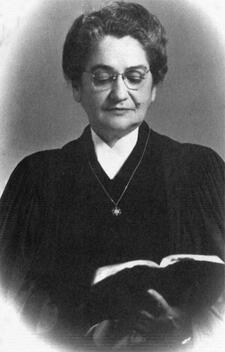
Paula Ackerman, reading from a religious text.
When Paula Ackerman's husband, William Ackerman, died in 1950, his congregation, the Reform Temple Beth Israel of Meridian, Mississippi, requested that she succeed him. Thus, Paula Ackerman became the first female spiritual leader of a mainstream Jewish congregation in the United States.
Institution:The Jacob Rader Marcus Center of the American Jewish Archives, Cincinnati, OH.
Reform Jewish leaders had not come to this position from observing the informal, but nevertheless real, religious leadership of women like Ray Frank and Paula Ackerman. Rather this posture evolved in the 1920s and 1930s after a series of formal challenges to the seminaries of Reform Judaism, Hebrew Union College and the Jewish Institute of Religion. (The two merged in 1950.) In the 1920s, following the Nineteenth Amendment granting women the right to vote and the heightened expectation that now all barriers to woman’s full equality would fall, a small number of women entered rabbinical school, hoping to become rabbis.
The first was Martha Neumark. In 1921, this seventeen-year-old student at Hebrew Union College launched a two-year-long debate over whether or not the college would ordain women rabbis. In the course of that debate Reform rabbis affirmed, in principle, that women could not be denied this privilege. But the college’s board of governors, fearing this departure from the past would constitute an irrevocable break with the more traditional sectors of American Jewry, prevented her from achieving her goal.
Neumark was not the only woman in the interwar years to challenge the exclusion of females from the rabbinate. Irma Levy Lindheim, Dora Askowith, and, most importantly, Helen Levinthal (later Lyons) raised the very same challenge. In 1939, the Jewish Institute of Religion awarded Helen Levinthal a master of Hebrew literature, not the rabbinical ordination she had sought and should have earned by completing the rabbinical school curriculum. Subsequently, like Ray Frank, Levinthal for a time exercised informal rabbinic leadership, preaching at High Holiday services in Brooklyn in 1939. But eventually she, like many of the other pioneers before and after her, settled down to a life as wife, mother, and exemplary Jewish volunteer.
The failure of each of these women to become a rabbi illustrates the roles—student, teacher, Jewish communal volunteer, and most importantly, wife and mother—sanctioned for American Jewish women at mid-century. Women could do many things in American Judaism then, but they could not yet become rabbis.
The First Women Become Rabbis
Within the next quarter century this would change. In 1972 in Reform Judaism, in 1974 in Reconstructionist Judaism, and in 1985 in Conservative Judaism, the first women received rabbinic ordination. That these women succeeded where those before them had failed reflected the coalescence of several factors. The long history of the question had paved the way in Reform Judaism. The new wave of American feminism of the 1960s renewed the nineteenth-century call for women’s access to the male professions. The elite seminaries producing rabbis thus became another of the exclusive male institutions and restricted professions then under siege, as women fought for and won access to places historically closed to them. By the 1970s and 1980s, equal rights for women came to sit squarely on the agenda of the majority of American Jews. Yet successfully resolving the question still depended, as it had in the past, upon the perseverance of individual women who continued to push for ordination for themselves.
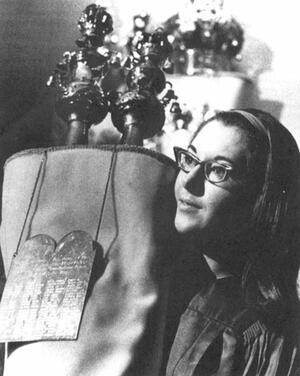
This photograph was taken in 1972, when Sally Jane Priesand became the first woman in the United States to be ordained as a rabbi. She faced many challenges on the road to acceptance. But she continued to struggle to carve a place for herself—and for all women—within the panoramic diversity of Judaism.
Institution: The Jacob Rader Marcus Center of the American Jewish Archives, Cincinnati, OH, www.americanjewisharchives.org and Garrett Cope, Citizen Patriot, Jackson, MI
In 1964, when Sally Priesand crossed the threshold of the Cincinnati campus of the Hebrew Union College–Jewish Institute of Religion as a freshman in its undergraduate program, she followed the path of pioneers, like Martha Neumark, who had already raised the question in the very same halls. But unlike the earlier unsuccessful challengers, the future Rabbi Priesand found an ever-widening circle of supporters, whose imaginations were sparked by the nascent feminist movement. Most important was the backing of the college’s president Nelson Glueck, whose wife, Helen, a hematologist, earned her M.D. in 1934. He decided to act on what his predecessors had simply asserted, woman’s right to ordination. At the same time, the Jewish and national press kept tabs on Priesand’s progress as a symbol of women’s liberation and the inroads it was making in American religion. In June 1972, Priesand became the first woman in America ordained a rabbi and the first in the world ordained by a rabbinical seminary. Already it was clear she would not be the last. (In 1935, in Germany, Regina Jonas received private ordination. She was murdered in Auschwitz.)
In Philadelphia at the same time, a new rabbinical school, the Reconstructionist Rabbinical College, had also admitted its first students. Once the liberal wing of Conservative Judaism, Reconstructionist Judaism had since split off. In 1968 its rabbinical school opened, and women were among its first students. In 1974, Sandy Eisenberg Sasso was ordained.
While the lengthy battle for women’s rabbinic ordination was fought largely on the ground of Reform Judaism, the campaign blazed fiercely, if comparatively briefly, in Conservative Judaism. In fact, Conservative Judaism was never utterly removed from the topic, as Henrietta Szold’s experience showed. But Seminary officials routinely diverted women interested in rabbinical school to their teacher-training programs.
As Sally Priesand was nearing ordination, the question surfaced anew in the Conservative movement. In the spring of 1972, a group of committed Conservative Jewish and passionately feminist women vociferously demanded equality in their branch of American Judaism. National media attention involved a wide audience in the debate. The New York Times published feature-length articles on the first women in Conservative synagogues in para-rabbinic jobs and those who abandoned Conservative Judaism to become Reform and Reconstructionist rabbis.
The result was that Conservative Jewish leaders found themselves inextricably entangled in the issue of women’s rabbinic ordination. For a long decade between 1972 and 1983, they engaged in an intricate political dance of shifting alliances, studies undertaken, commissions formed, hearings held, motions tabled, and votes counted. Finally, in 1983, over the objection of a number of colleagues who boycotted the vote, the faculty of the Jewish Theological Seminary agreed to admit women to the rabbinical school. Two years later, Amy Eilberg, one of a cluster of women waiting in the wings for a favorable decision, biding their time by taking the curriculum necessary for rabbinic ordination, was ordained.
Rabba, Maharat, Rabbanit, Rabbi: Orthodox Women Rabbis
That no sector of American Judaism has been immune from the challenge of women’s religious equality, symbolically represented by female ordination, became evident when the woman rabbi surfaced in Orthodox Judaism.
In 1984, the feminist-activist-writer-poet rebbetzin Blu Greenberg published the essay “Will there be Orthodox women rabbis?” There she wrote how one night, while her then seven-year old daughter was bathing, the child began wondering what she would be when she grew up. Maybe I’ll be a rabbi, she announced. Greenberg wondered where did she ever get the idea that a girl could be a rabbi.
Astoundingly, Greenberg laid out the trajectory of Orthodox women’s ordination. With Jewish institutions for women’s higher learning already emerging by 1984, a revolution was opening up Torah and text study to girls and women. No longer were these texts, the basis of rabbinical education, the exclusive province of Jewish men as they had been for millennia. The access route to Orthodox female religious authority was being paved. It was only a matter of time before that education would produce deeply pious, learned women who, if they were men, would have become rabbis. Greenberg expected that one day a small cluster of maverick rabbis would stand up to the censure they were sure to receive from their colleagues and dare to ordain these women.
As had happened in the other sectors of modern Judaism, brave pioneers began pushing the question for themselves. In the 1990s, one applied for admission to Yeshiva University’s rabbinical school. Rejected for her sex, Haviva Ner-David, after a decade of study, was privately ordained in 2006 by an Orthodox rabbi. She calls herself rabbi, although Aryeh Strikovsky, who signed her ordination, deliberately avoided the term. But Ner-David was not even the first. Mimi Feigelson, known as Reb Mimi, was ordained in 1994 by disciples of the charismatic rabbi Shlomo Carlebach, and, since then, has called herself an Israeli Orthodox woman rabbi.
Then there is Rabba Sara Hurwitz. After college, Hurwitz studied at Drisha, founded in 1979 as the world’s first institute for women’s advanced Jewish text study. She never enrolled in rabbinical school because no Orthodox one was open to her. Instead, she embarked on a five-year-long course of private study with Rabbi Avi Weiss at the Hebrew Institute of Riverdale in New York and served as his congregational intern. In 2009, he ordained her inventing the title “maharat,” an acronym of the Hebrew (manhiga hilkhatit ruikhanit toranit) for female leader of Jewish law, spirituality, and Torah. At the time, the event scarcely made the news. After all, by then, in Israel, women who had mastered Jewish legal texts had been accepted as advocates for women appearing before rabbinical courts and as advisors to women on legal matters pertaining to female sexuality (yoetzet halachah).
But, a few months later, when Weiss decided to clarify for his congregants Hurwitz’s position as a member of the Hebrew Institute’s clergy as she visited the sick and conducted funerals, he gave her the title rabba. Rabba is one way of rendering in Hebrew, a language that has no neuter gender, the feminine of rabbi. The title unleashed a firestorm. But it did not stop Rabbi Weiss and Rabba Hurwitz.
They had already opened Yeshivat Maharat to educate and ordain committed Orthodox women. In 2013, its first three female ordainees took the title maharat. But, since then Yeshivat Maharat—which, as of 2019, had ordained another 23 women and had 30 in the pipeline—permits these future clergy to choose their honorific at ordination. Some continue to take the title maharat; others prefer rabba. Rabbanit, another way of rendering rabbi in the feminine, has also won favor. Historically rabbanit signified the wife of a rabbi. But these women use it to show that they are masters of Jewish law. In 2015, for the first, but surely not the last, time, one Yeshivat Maharat graduate, Lila Kagedan, chose the title “rabbi.”
Elsewhere in the modern and centrist Orthodox world, opposition remains: The Rabbinical Council of America, comprised mostly of alumni from New York’s Yeshiva University, the flagship seminary of modern and centrist Orthodoxy, continues to reiterate its opposition to ordaining women, no matter the title. For the sectors of the Orthodox world farther to the right, like the Hasidim and the yeshivish, traditionalist affirmations of essentialist male and female difference apparently make the question of women rabbis moot.
But, with women being ordained in Orthodox settings in Israel too, no matter the title— rabba, maharat, rabbanit, rabbi—the first generation of women Orthodox rabbis has arrived.
LGBTQ Rabbis
Once women had broken the stereotype of who could be a rabbi, they paved the way for the ordination of gay men, lesbians, and transgendered men and women as well. The Torah, whose laws and proscriptions Jews historically observed, considers homosexuality abhorrent: “Do not lie with a male as one lies with a woman; it is an abomination" (Leviticus 18:22). Rabbis were traditionally expected to be married and the fathers of children. Surely gay men became rabbis in the Jewish past, but their history is invisible.
The American movement for gay rights launched by 1969’s Stonewall riots coincided with the entrance of women into the rabbinate. By the mid-1980s, gay and lesbian rabbis and rabbinical students—the former remaining in the closet to keep their jobs, the latter to receive ordination—began meeting secretly to support each other and strategize. On the one hand, they had very public roles as clergy and clergy-in-training. On the other hand, they had to be private in order to protect themselves. Some of those attending the retreats of the underground group Ameinu, like Rabbi Sharon Kleinbaum—who, for more than 25 years, has been the rabbi of New York’s Congregation Beit Simchat Torah, founded in 1973 as a gay synagogue—became trailblazers on gay and lesbian issues in the Jewish world.
In 1984, the Reconstructionist Rabbinical College became the first denomination of American Judaism to admit openly gay students. While the rabbis of Reform Judaism had called for an end to a discrimination against gay people in 1977, not until 1990—after Rabbi Stacy Offner, who remained closeted in rabbinical school, had come out to her congregation and had her contract renewed—did the movement ordain openly gay students.
Once again, the clash over the issue was particularly contentious within the Conservative movement. Unlike Reform and Reconstructionist Judaism, Conservative Judaism remains bound by Jewish law as interpreted by its rabbis. In 2006, the movement’s law committee accepted an opinion that allowed for ordination of gays and lesbians. Five years later, Rabbi Carie Carter of the Park Slope Jewish Center, by then open as a lesbian after having remained closeted during rabbinical school, participated in the ordination of Rachel Isaacs, the first openly gay student ordained at the Jewish Theological Seminary.
The question also has surfaced in the most open sectors of the Orthodox world, thanks to the influence of the powerful film Trembling before G-d (2001) about Orthodox Jewish gays’ and lesbians’ struggles with their faith and their sexualities. Rabbi Steven Greenberg, a graduate of Yeshiva University, is considered the firstly openly gay Orthodox rabbi.
Reinventing the Rabbinate
The prehistory of women rabbis closed with the decision to ordain the first women. Since then, hundreds, if not already more than a thousand, women have become rabbis.
Just as Mary M. Cohen’s character had stunned her audience by posing the very notion of women in the rabbinate, the first female rabbis jolted American Judaism. Not content with simply replicating what they found in synagogue life, they self-consciously perceived themselves as trailblazers. They voiced, to some ears stridently, a critique of Judaism’s status quo, arguing that it was largely created by men and that, for far too long, it had marginalized women. Standing in their own eyes as pathbreakers, these rabbis have collectively pushed American Judaism toward an egalitarian future, one that fully incorporates women’s many different voices.
But before the very first female rabbis could begin to raise their concerns, they had to win approval from a wide swathe of American Jewry. The very first women in the rabbinate discovered that ordination was just the first hurdle. Those ordained in the 1970s and early 1980s, before a significant cohort of women rabbis emerged, found themselves struggling for acceptance. Congregations refused to interview them for jobs. Community boards of rabbis opposed their participation. Conservatism’s Rabbinical Assembly, the collective of rabbis that for years had routinely admitted to its ranks rabbis trained at Reform seminaries, turned away qualified female applicants ordained at Hebrew Union College-Jewish Institute of Religion.
At the same time, the new rabbis found themselves struggling to overcome the conviction that this was one job women could not possibly do. Congregants worried that women rabbis could not carry heavy Torah scrolls. They feared that the women would be too soft-spoken for the job, or alternatively that they would always preach on feminism. Unaccustomed to seeing women in the male ritual garb of kippa (skullcap) and tallit, congregants displayed their sense that women rabbis disturbed the traditions they knew.
Drawing upon the strategies pioneered by the feminist movement, the first female rabbis organized to challenge these objections. Via Reform’s Women’s Rabbinic Network and the Central Conference of American Rabbis Task Force on Women in the Rabbinate, they began addressing these and a host of other issues, like maternity-leave policies, which had never concerned an all-male rabbinate.
Yet, inequities remain today. Studies prove that male rabbis earn more than their comparable female counterparts and that women are less likely to become senior rabbis at large congregations. Some of the women who became rabbis continue to point discriminatory assumptions about their limitations and roles.
As more and more women entered the ranks of the rabbinate, some of the initial difficulties waned and new questions emerged. Among them was whether or not women rabbis perform their roles differently than their male colleagues, and, if so, what that bodes for the future of American Judaism. Extensive interviews revealed that the first generation of women rabbis contended—although their male peers by and large denied this then—that, as women, they offered a different model for the rabbinate. Self-consciously reflecting the influential work of psychologist Carol Gilligan, the female rabbis described themselves as more approachable, more prone to involve their congregants, and more likely to speak sermons in a different voice.
Determined to bring their perspectives as American and Jewish—and often as feminist—women to bear upon American Judaism, many have sharply critiqued Judaism’s historical marginalization of women’s religious activities. They have sought to mark the major milestones of women’s biological lives—menarche, childbirth, menopause—and created rituals to celebrate a positive pregnancy test, grieve a miscarriage, and welcome a daughter to the Jewish people. They reclaimed the mikveh, the ritual bath, from a space that marked the end of sexual abstinence in marriage during and after a woman’s menstrual cycle to a place offering closure after divorce or recovery from rape. Some female rabbis became leaders in the new Jewish healing movement, others in Jewish environmentalism.
The women who became rabbis wrote female-inclusive and gender-neutral liturgies, poetry, and songs. They have given new life to an older literary form, the tkhines, books of prayers intended for women’s private mediations. They have interpreted anew texts previously read through male eyes that ignored women’s voices. Some have written for children, believing that the key to change lies in shaping the next generation’s perspective on gender and Judaism. Others have crafted new midrashim, using their imaginations to re-read ancient texts and infuse them with female and feminist perspectives.
In so doing, these leaders of American Judaism have pioneered and challenged not only the institution of the rabbinate but also American Jews and American Judaism to listen, at long last, to the voices of women.
Alpert, Rebecca, Sue Levi Elwell, and Shirley Idelson, eds. Lesbian Rabbis: The First Generation. New Brunswick, NJ: Rutgers University Press, 2001.
Central Conference of American Rabbis. Yearbook, Vol. 32. New York: Central Conference of American Rabbis, 1922.
Cardin, Nina Beth. Tears of Sorrow, Seeds of Hope: A Jewish Spiritual Companion for Infertility and Pregnancy Loss. Nashville, TN: Jewish Lights, 1999.
Clar, Reva, and William M. Kramer. “The Girl Rabbi of the Golden West: The Adventurous Life of Ray Frank in Nevada, California and the Northwest.” Western States Jewish History 18 (1986): 99–111, 23–236, 336–351.
Fishman, Sylvia Barack. A Breath of Life: Feminism in the American Jewish Community. Waltham, MA: Brandeis University Press, 1995.
Frank, Ray. “Women in the Synagogue.” In Papers of the Jewish Women’s Congress. Philadelphia: Jewish Publication Society of America, 1894.
Greenberg, Simon, ed. The Ordination of Women as Rabbis: Studies and Responsa. New York: Jewish Theological Society Press, 1988.
Himmelstein, Drew. “The Untold Story of Ameinu.” Tablet Magazine, June 26, 2019; https://www.tabletmag.com/jewish-life-and-religion/286430/the-untold-story-of-ameinu.
Nadell, Pamela S. “‘Top Down’ or ‘Bottom Up’: Two Movements for Women’s Rabbinic Ordination.” In An Inventory of Promises: Essays in Honor of Moses Rischin, edited by Jeffrey Gurock and Marc Lee Raphael. New York: Carlson Publishing, 1995.
Nadell, Pamela S. “The Women Who Would Be Rabbis.” In Gender and Judaism, edited by T.M. Rudavsky. New York: New York University Press, 1995.
Nadell, Pamela S. “Rabbi, Rabba, Maharat, Rabbanit: For Orthodox Jewish Women, What's In a Title?” Sightings, January 28, 2016); https://divinity.uchicago.edu/sightings/rabbi-rabba-maharat-rabbanit-orthodox-jewish-women-whats-title.
Nadell, Pamela S. Women Who Would Be Rabbis: A History of Women’s Ordination 1889–1985. Boston: Beacon, 2000.
Portnoy, Mindy Avra. Ima on the Bimah: My Mommy Is a Rabbi. Steffi Karen Rubin, illustrator. Minneapolis: Kar-Ben Publishing, 1986.
Schorr, Rebecca Einstein, and Alysa Mendelson Graf, eds. The Sacred Calling: Four Decades of Women in the Rabbinate. New York: CCAR Press, 2016.
Simon, Rita J., and Pamela S. Nadell. “In the Same Voice or Is It Different? Gender and the Clergy.” Sociology of Religion 56, 1 (1995): 63–70.
Simon, Rita J. and Pamela S. Nadell. “Lay Leaders’ Views About Female Rabbis and Ministers.” Shofar 13, 4 (Summer 1995): 52–58.
Simon, Rita J. and Pamela S. Nadell. “Teachers, Preachers, and Feminists in America: Women Rabbis.” Shofar 10, 1 (Fall 1991): 2–10.
Simon, Rita J., Angela Scanlan, and Pamela S. Nadell. “Rabbis and Ministers: Women of the Book and the Cloth.” In Gender and Religion, edited by William Swatos, Jr. Livingston, NJ: Transaction Publishers, 1994; also in Rita Simon, Rabbis, Lawyers, Immigrants, Thieves: Exploring Women’s Roles. Westport, CT: Praeger, 1993.
Ner-David, Haviva. Life on the Fringes: A Feminist Journey toward Traditional Rabbinic Ordination. Needham, MA: JFL Books, 2000.
Szold, Henrietta. Letter to Judge Mayer Sulzberger, February 14, 1903. Henrietta Zold [sic] Papers, Jewish Historical Society of Maryland.
Wertheimer, Jack. A People Divided: Judaism in Contemporary America. Hanover, NH: Brandeis University Press, 1993.


